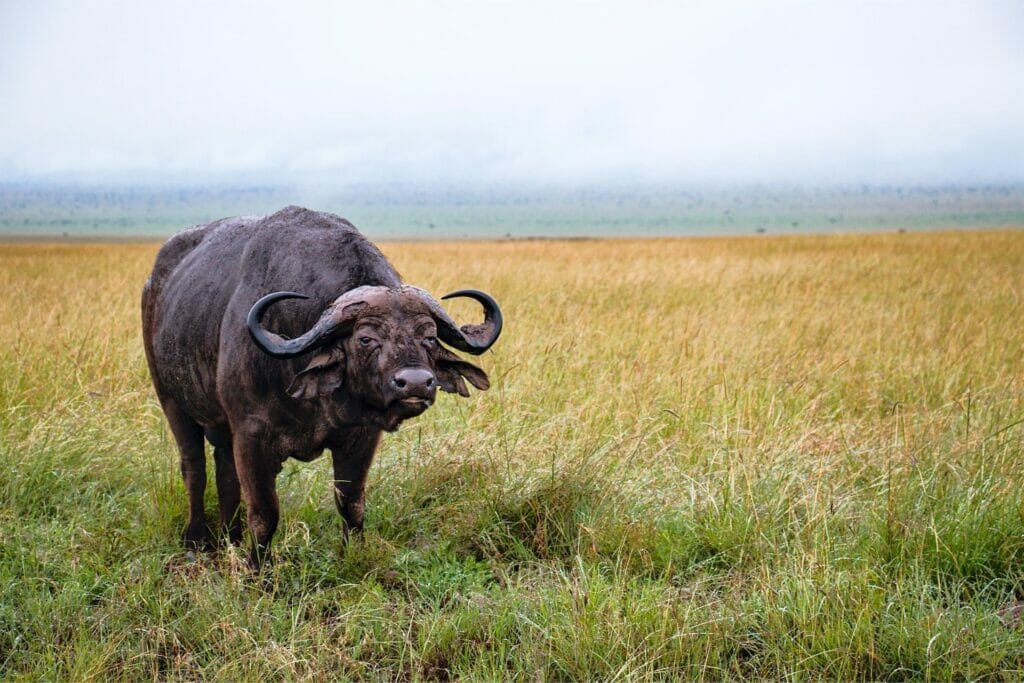What you don’t know about the Cape buffalo
Cape buffalo, also known as African buffalo, are a common sight on safaris in East Africa. These majestic animals are known for their impressive size and strength, and are a keystone species in the African savanna ecosystem. Cape buffalo are herbivores, feeding on grasses, herbs, and shrubs.
They are often found in large herds, which can number in the thousands, and are known for their strong social bonds. When threatened, Cape buffalo are known to be extremely dangerous, and have been known to attack and kill humans and other predators.
Despite their reputation for being aggressive, Cape buffalo are a vital part of the African savannah and a must-see for any safari-goer.
Planning your first safari to East Africa? Then you’ll want to keep reading to learn more about the Cape buffalo and just where you can find them!
Interesting Facts About The Cape Buffalo

How do Cape buffalo compare with the rest of the African buffalo?
Cape buffalo are actually one of four subspecies of the African buffalo. They are also the most common. You can identify a Cape buffalo by its color, size, and horn shape.
The other African buffalo subspecies are the forest buffalo, the West Africa savanna buffalo, and the Central Africa savanna buffalo.
Are Cape buffalo the same as bison?
For fans of American history, there can be confusion between the idea of bison and buffalo. American settlers called “bison” buffalo because they had some similarities, namely that they were large, brown, and big beasts that grazed.
Though they are from the same bovine subfamily, they are different genuses.
Want a quick way to tell them apart? Bison have beards. Buffalo don’t have beards.
Where can I find Cape buffalo?
Cape buffalo can be found throughout Southern and East Africa, including Tanzania, Uganda, and Rwanda. They are hardy and able to survive in a range of habitats, including lowland rainforests, coastal savannahs, and semi-arid bushlands. All they need is a water source, and they can pretty much take care of the rest.
Why do buffalo cover themselves in mud?
No, these Cape buffalo are not giving themselves a spa treatment. The mud on their back helps protect them from ticks and parasites that tend to latch onto their skin.
If you see birds going for a ride, know that they’re profiting from the free snacks and dining on lice, fleas, and parasites – all while giving their wings a break.
How big are Cape buffalo herds?
Safety in numbers, right? Though Cape buffalo are pretty fierce, they still prefer to travel in herds to discourage Africa’s many predators, including African wild dogs, hyenas, leopards, and lions. These herds range from 50 to 500 members, though that can grow past the thousands during the rainy season in the Serengeti.
Are Cape buffalo part of the big five animals?
Yes, Cape buffalo are part of the big 5 animal group, along with leopards, lions, African elephants, and rhinos.
Once considered a prize trophy, Cape buffalo are famously difficult. And because they can run up to 37 miles per hour, they are famously dangerous.
What is the Cape buffalo’s horn for?

As if the Cape buffalo wasn’t imposing enough, its curved horn adds another layer to this nearly seven-foot-long animal. Both female and male Cape buffalo have horns. Females’ horns are narrower and smaller than their male counterparts, whose horns are used to determine dominance when it comes time to mate.
Where To See Cape Buffalo in Uganda
As Uganda safari specialists, it’s our passion to show you some of East Africa’s most incredible wildlife in our home country.
The Cape buffalo can be found in any national parks with savanna, including Kidepo Valley National Park, Murchison Falls National Park, and Queen Elizabeth National Park.
Because they tend to wade into shallow waters, you’ll have the chance to see them on game drives (in both the morning and evening), as well as on a boat tour in the Kazinga Channel in Queen Elizabeth National Park.
Come See Cape Buffalo in Uganda With Kikooko
Curious to know more about where to see Cape buffalo in Uganda? Interested to find the Big 5 in Uganda? We’d be happy to help craft a tailor-made itinerary just for you.
As safari specialists who have been offering tours in Uganda since 2013, we have the experience and the connections to deliver you that just-right tour at a price that fits your budget. When you’re ready to get started planning, please feel free to send us a message.




